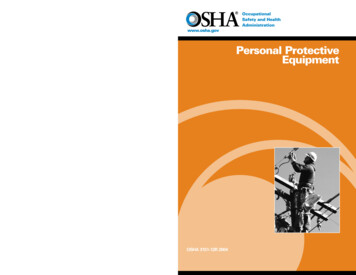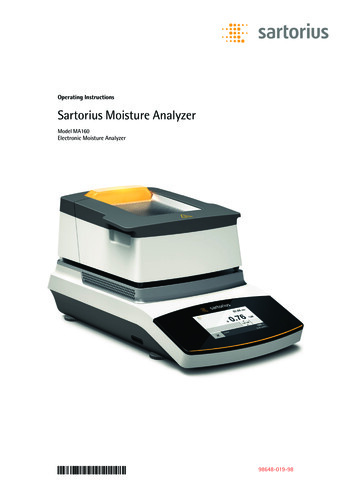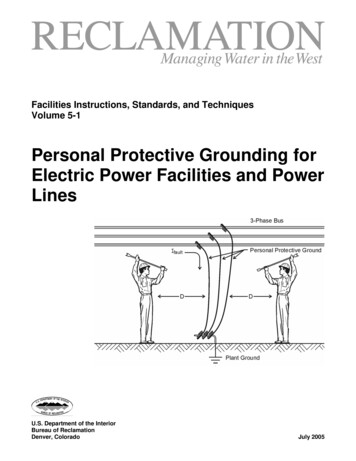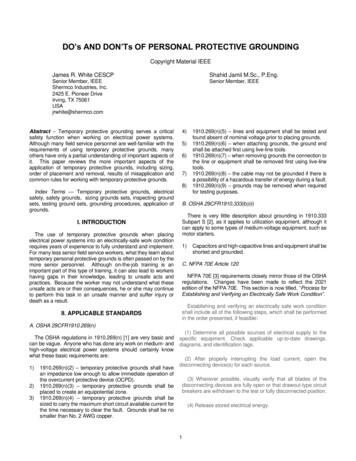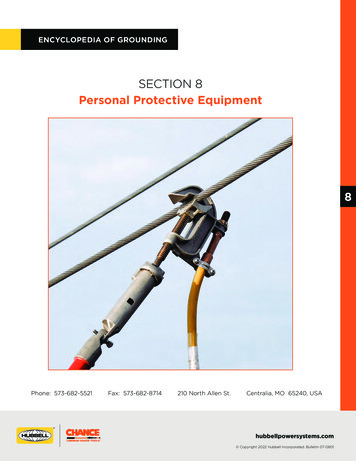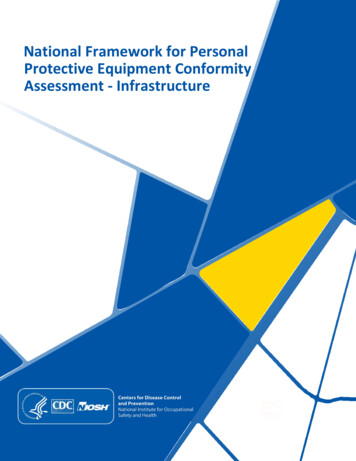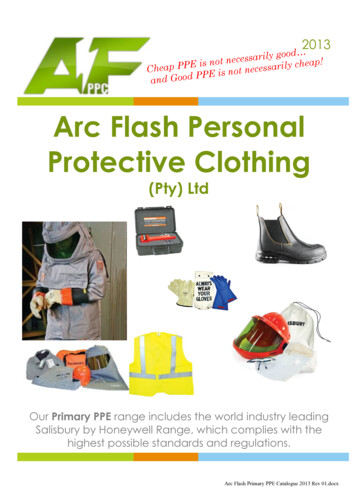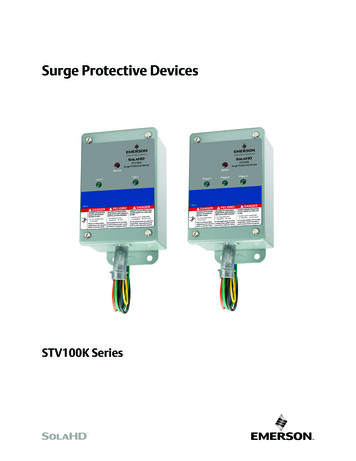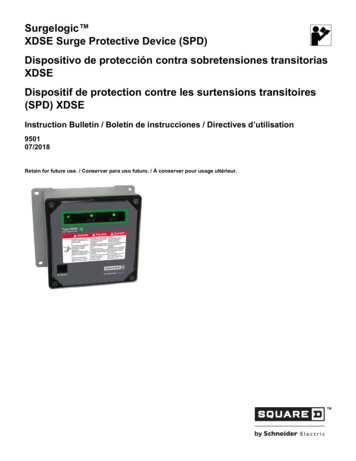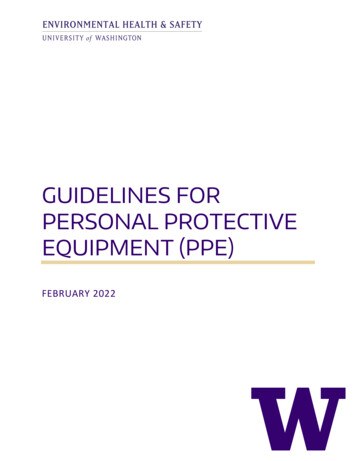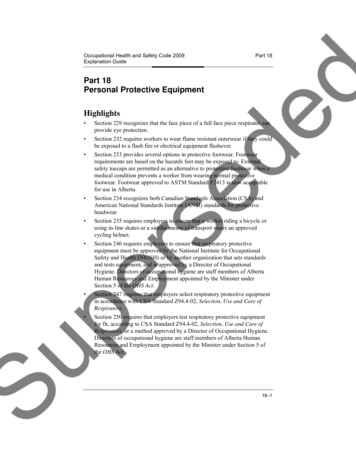
Transcription
Occupational Health and Safety Code 2009Explanation GuidePart 18Part 18Personal Protective EquipmentHighlights Section 229 recognizes that the face piece of a full face piece respirator canprovide eye protection.Section 232 requires workers to wear flame resistant outerwear if they couldbe exposed to a flash fire or electrical equipment flashover.Section 233 provides several options in protective footwear. Footwearrequirements are based on the hazards feet may be exposed to. Externalsafety toecaps are permitted as an alternative to protective footwear when amedical condition prevents a worker from wearing normal protectivefootwear. Footwear approved to ASTM Standard F2413 is now acceptablefor use in Alberta.Section 234 recognizes both Canadian Standards Association (CSA) andAmerican National Standards Institute (ANSI) standards for protectiveheadwear.Section 235 requires employers to ensure that a worker riding a bicycle orusing in-line skates or a similar means of transport wears an approvedcycling helmet.Section 246 requires employers to ensure that respiratory protectiveequipment must be approved by the National Institute for OccupationalSafety and Health (NIOSH) or by another organization that sets standardsand tests equipment, and is approved by a Director of OccupationalHygiene. Directors of occupational hygiene are staff members of AlbertaHuman Resources and Employment appointed by the Minister underSection 5 of the OHS Act.Section 247 requires that employers select respiratory protective equipmentin accordance with CSA Standard Z94.4-02, Selection, Use and Care ofRespirators.Section 250 requires that employers test respiratory protective equipmentfor fit, according to CSA Standard Z94.4-02, Selection, Use and Care ofRespirators, or a method approved by a Director of Occupational Hygiene.Directors of occupational hygiene are staff members of Alberta HumanResources and Employment appointed by the Minister under Section 5 ofthe OHS Act.18–1
Occupational Health and Safety Code 2009Explanation GuidePart 18RequirementsSection 228 Duty to use personal protective equipmentSubsection 228(1)If the hazard assessment required by section 7 of the OHS Code indicates thatPPE is required, the employer must ensure that workers wear and use therequired PPE properly. Ensuring that workers have and wear their PPE is notenough. The employer must ensure that the PPE is used properly.The OHS Code requires employers to provide PPE in a limited number ofsituations where, for example, there is a breathing hazard or where noiseexposure limits are exceeded. This section does not require employers to providePPE such as hard hats, safety boots, flame resistant clothing or eye protection.Where such equipment is necessary, employers must make sure that workers useit.Regardless of who supplies the PPE, paragraph 228(1)(c) makes the employerresponsible for ensuring that the PPE is in a condition to perform the functionfor which it was designed. Cracked eye protection, worn out safety boots andexcessively dirty flame resistant overalls are examples of conditions thatemployers need to be aware of and either correct or have corrected.For PPE to be effective, workers must be trained in its correct use, care,limitations and assigned maintenance. The employer is responsible for providingthis training. Workers must be aware that wearing and using PPE does noteliminate the hazard. If the PPE fails, the worker will be exposed to the hazard.Workers need to understand that PPE must not be altered or removed eventhough they may find it uncomfortable — sometimes equipment may beuncomfortable simply because it does not fit properly.Employers exceeding the requirements of Part 18This Part uses language such as “If a worker’s eyes may be injured orirritated ”, “If a worker may be exposed to a flash fire ”, “If the hazardassessment identifies that protective footwear needs to ”, and “If there is aforeseeable danger of injury ”. In all cases, it is the employer’s responsibilityto assess the presence and significance of the relevant hazard, determining ifworkers should use a particular type of personal protective equipment.18–2
Occupational Health and Safety Code 2009Explanation GuidePart 18There are situations in which no foreseeable danger exists – either at a portion ofthe work site or at the entire work site – yet an employer still requires thatworkers use a particular type of personal protective equipment. In suchsituations the employer has usually set a blanket policy that all workers must usethe personal protective equipment regardless of where workers are to on thework site and regardless of the presence or absence of the hazard.Employers have the freedom to set and enforce such a policy as the policy doesnot violate the requirements of the OHS Code. Such a policy exceeds theminimum requirements of the OHS Code. The reason for an employer institutingsuch a policy often has to do with ease of enforcement at a work site i.e.everyone wears the personal protective equipment all the time so there is nodiscussion as to whether a worker should or should not be wearing it at aparticular time and location at the work site.When a worker questions the authority of the employer to set such a policy,Workplace Health and Safety confirms that the policy exceeds the requirementsof the OHS Code and it is the employer’s right to do so. If a worker chooses tocontravene the employer’s policy, the resulting situation is a personnel issue, nota safety issue.Subsection 228(2)Workers have several obligations. Workers must use PPE according to thetraining and instruction they receive. Workers must inspect PPE prior to use andnot use PPE found to be in a condition that makes the PPE unsuitable for use.For example, if a worker required to use a self-contained breathing apparatus(SCBA) cannot get a good facial seal because the face piece is too small, theworker must not use the apparatus. Subsection 14(2) of the OHS Regulationrequires workers to report this situation to the employer so that it can becorrected.Subsection 228(3)The use of PPE must not itself endanger the worker. Examples of such situationsare:(a) safety toecaps in place of protective footwear — a worker wearing toecapsshould not be required to do much walking around the work site. Thetoecaps may create a tripping hazard;(b) a poorly fitting suit worn to prevent exposure to chemicals may not sealwell at the wrists and ankles; and(c) a faceshield covered with dirt and debris may affect a worker’s ability to seeclearly.18–3
Occupational Health and Safety Code 2009Explanation GuidePart 18Eye ProtectionSection 229 Compliance with standardsSubsection 229(1)If a worker’s eyes may be injured or irritated at a work site, the employer isrequired to ensure that the worker wears eye protection equipment that isapproved to CSA Standard Z94.3-07, Eye and Face Protectors, CSA StandardZ94.3-02, Industrial Eye and Face Protectors, or CAN/CSA-Z94.3-99,Industrial Eye and Face Protectors. For compliance purposes, at least onecomponent of an assembled product or system must bear the mark or label of anationally accredited testing organization such as CSA, UL, SEI, etc. Forexample, if the mark or label appears on the frame, then the entire product isapproved; if the mark or label appears on an earpiece, then the entire product isapproved.The CSA Standard sets minimum performance requirements for the testing ofindustrial eye and face protection. This includes testing for impact resistance,ignition/flammability, visibility, field of view and other characteristics. With theexception of subsections 229(2.3) and 229(3), eye and face protectors meetingthe requirements of the 1989 or 2003 editions of ANSI Standard Z87.1,Occupational and Educational Eye and Face Protection, are not recognized bythe OHS Code.The employer is not required to pay for and provide eye protection equipment.However, the employer is required to ensure that a worker wears suchequipment if a worker’s eyes may be injured or irritated at a work site. Theemployer is also required to ensure that the eye protection equipment selected isappropriate to the work being done and the hazard(s) involved.Situations can arise in which the eyes are exposed to multiple hazards all at thesame time. When this happens, protection must be provided against the highestlevel of each hazard. For example, if the work involves both flying particles andthe possibility of an acid splash, using spectacles is not good enough. At aminimum, Class 2B goggles must be used. The following paragraphs describethe CSA Classes of protective equipment available and Table 18.1 recommendsthe type of protective equipment that should be used based on the hazard.For more informationProtective Eyewear: A User’s Guide. CSA Special Publication Z94.3.1-02.Canadian Standards Association, February 2002.18–4
Occupational Health and Safety Code 2009Explanation GuidePart 18CSA classification of eye and face protectorsThe CSA Standards classify eye and face protection into seven classes as follow:Class 1 — Spectacles (see Figure 18.1) Class 1A spectacles for impact protection with side protection Class 1B spectacles for impact and radiation protection with side protectionFigure 18.1 SpectaclesClass 2 — Goggles (see Figure 18.2) Class 2A goggles for impact protection with direct ventilation Class 2B goggles for impact, dust and splash protection; non-ventilated andindirectly ventilated Class 2C goggles are Class 2A or 2B goggles with radiation protectionFigure 18.2 Goggles18–5
Occupational Health and Safety Code 2009Explanation GuidePart 18Class 3 — Welding helmets (see Figure 18.3) This Class includes a variety of configurationsFigure 18.3 Welding helmetsClass 4— Welding hand shields (see Figure 18.4) This Class includes a variety of configurationsFigure 18.4 Welding hand shieldsClass 5— Non-rigid helmets (hoods) (see Figure 18.5) Class 5A non-rigid helmets have an impact-resistant window Class 5B non-rigid helmets are intended for dust, splash and abrasivematerials protection Class 5C non-rigid helmets have radiation protection Class 5D non-rigid helmets are intended for high-heat applications18–6
Occupational Health and Safety Code 2009Explanation GuidePart 18Figure 18.5 Non-rigid helmet (hood)Class 6— Faceshields (see Figure 18.6) Class 6A faceshields offer impact and splash protection Class 6B faceshields offer radiation protection Class 6C faceshields are intended for high-heat applicationsFigure 18.6 FaceshieldsClass 7 — Respirator facepieces (see Figure 18.7) Class 7A respirator facepieces offer impact and splash protection Class 7B respirator facepieces are Class 7A respirator facepieces withradiation protection Class 7C respirator facepieces have loose-fitting hoods or helmets Class 7D respirator facepieces are Class 7C respirator facepieces withradiation protection18–7
Occupational Health and Safety Code 2009Explanation GuidePart 18Figure 18.7 Respirator facepieces18–8
Occupational Health and Safety Code 2009Explanation GuideTable 18.1Nature ofhazardFlying objectsFlying particles,dust, wind, etc.Heat, sparks,and splashfrom moltenmaterialsPart 1818–9Hazards and recommended eye and face protectorsTypical hazardous activitiesChipping, scaling,stonework, drilling,grinding, buffing, polishing,etc; hammer mills,crushing, heavy sawing,planing; wire and striphandling; hammering,unpacking, nailing; punchpress, lathe work, etc.Woodworking, sanding;light metalworking andmachining; exposure todust and wind; resistancewelding (no radiationexposure); sand cement,aggregate handling;painting; concrete work,plastering; materialbatching and mixingBabbiting, casting, pouringmolten metal; brazing,soldering, spot welding,stud welding; hot dippingoperationsSpectaclesClass 1Goggles Class 2AABBCWeldinghelmetClass 3WeldinghandshieldsClass 4Non-rigid hoods Class 5ABCDFaceshieldsClass 6ABC
Occupational Health and Safety Code 2009Explanation GuideNature ofhazardAcid splash;chemical burnsAbrasiveblastingmaterialsGlare, straylightOpticalradiation thatcan injure theeyes (wheremoderatereduction ofoptical radiationis required)Opticalradiation thatcan injure theeyes (wherelarge reductionof opticalradiation isrequired)Typical hazardous activitiesPart 18SpectaclesClass 1Goggles Class 2AABBCAcid and alkali handling;degreasing, pickling andplating operations; glassbreakage; chemical spray;liquid bitumen handlingSand blasting; shotblasting; shotcretingReflection, bright sun, andlights; reflected weldingflash; photographic copyingTorch cutting, welding,brazing, furnace work;metal pouring, spotwelding, photographiccopyingElectric arc welding; heavygas cutting; plasmaspraying and cutting; inertgas shielded arc welding;atomic hydrogen weldingSource: Based on Table A.1 of CSA Standard Z94.3-02 Eye and Face Protectors18–10WeldinghelmetClass 3WeldinghandshieldsClass 4Non-rigid hoods Class 5ABCDFaceshieldsClass 6ABC
Occupational Health and Safety Code 2009Explanation GuidePart 18Subsection 229(2)Even if prescription eyewear is made with “impact resistant” plastic lenses, theeyewear still does not protect the eyes like safety eyewear. Some of thedifferences between safety and prescription eyewear are:(a) safety eyewear must meet the impact strength requirements of the CSAStandards listed — able to withstand the impact of a 6.4 millimeter diametersteel ball travelling at 46.5 metres/second. Prescription eyewear is notsubjected to such a test;(b) safety eyewear frames must be manufactured so that when struck by anobject, the lenses cannot be pushed through the back of the frame into thewearer’s face. Prescription eyewear may not have this feature; and(c) safety eyewear must have side protection, meet safety standard dimensionrequirements, and be tested as a complete protector. Prescription eyewearmay not meet these requirements.For those who need it, prescription safety eyewear is available fromoptometrists. Such eyewear meets the requirements of the referenced CSAStandards by using certified lenses and frames. Acceptable prescription safetyeyewear has the following characteristics:(a) lenses are etched or marked with the manufacturer’s identification; and(b) frames are marked with the manufacturer’s trademark and the mark or labelof the nationally accredited testing organization that evaluated and approvedthe eyewear to one of the listed CSA Standards.Subsections 229(2.1) and 229(2.2)These subsections recognize that in some cases, prescription safety eyewearmust be used that has treated safety glass lenses rather than plastic lenses. Forexample, a work environment may contain an atmosphere that could becorrosive to a plastic lens. Where this is the case, the lenses made of glass mustmeet the requirements of at least one of the listed ANSI standards. The ANSIstandards are referenced because the use of glass lenses is not recognized byCSA’s protective eyewear standards.Prescription safety eyewear having bifocal, trifocal or progressive i.e. a range offocal lengths from near to far distances, glass lenses has limited impactresistance. As a result, glass lenses must not be used where there is a danger ofimpact, i.e. there is a probability that the lens can be struck by some object,unless they are worn behind eye protection equipment approved to at least oneof the CSA standards listed in subsection 229(1).18–11
Occupational Health and Safety Code 2009Explanation GuidePart 18Subsection 229(2.3)Practically speaking, prescription safety eyewear sometimes uses ANSIcompliant frames with CSA-compliant lenses. This subsection acknowledgesthis situation and allows it.Subsection 229(3)Situations may arise in which a full face piece respirator is required and thework also requires the eyes and face to be protected from debris, flying particlesand dust. In the past, the performance of such work required the use of both arespirator and approved protective eyewear. This approach often reduced theability of workers to see properly and was cumbersome.The referenced editions of CSA Standard Z94.3 include impact testing ofrespirator face pieces, eliminating the need for additional protective eyewear.However at the time of release of the OHS Code, CSA does not yet have acertification program in place to test respirator face pieces to the newrequirements. Until a certification program is in place, respirator face piecesmeeting the faceshield impact requirements of section 9 of the referencededitions of ANSI Standard Z87.1, Practice for Occupational Health andEducational Eye and Face Protection, are considered acceptable. It isunderstood that CSA will have a certification program in place in the nearfuture.Section 230 Contact lensesOpinions about the safety of contact lenses at the workplace vary widely. Thecritical point is that contact lenses are not intended to be used as protectivedevices. They are not a substitute for personal protective equipment. If eye andface protection is required for certain work operations, then all workers,including contact lens wearers, must wear the proper protective devices. Thearguments against wearing contact lenses are that(a) dusts or chemicals can be trapped behind the lens and cause irritation ordamage to the cornea,(b) gases and vapours can irritate the eyes and cause excessive watering, and(c) chemical splashes may do more harm when contact lenses are worn. If lensremoval is delayed, first aid treatment may not be as effective and, as aresult, the eye’s exposure time to the chemical may be increased.However, the opposite may be true as well. Contact lenses may prevent somesubstances from reaching the eye, minimizing or even preventing an injury.Both situations have been documented.18–12
Occupational Health and Safety Code 2009Explanation GuidePart 18If wearing contact lenses poses a hazard to the worker’s eyes during workactivities, this section requires the employer to advise the worker of the hazardsand the alternatives available to contact lenses. Additional information aboutcontact lens use at the workplace is described in the materials referenced below.For more WHS/WHS-PUB mg001.pdfGuideline for the Use of Contact Lenses in /WHS-PUB eyeinja.pdfEye Injury Prevention in IndustrySection 231 Electric arc weldingA worker performing electric arc welding is responsible for ensuring that allworkers in the area are protected from exposure to the radiation created by thearc. Workers in the area can be protected if they wear appropriate eye protectionor the arc welding is done behind a screen as shown in Figure 18.8.Figure 18.8 Examples of protective screens used in arc welding18–13
Occupational Health and Safety Code 2009Explanation GuidePart 18Section 232 Flame resistant clothingFlash fires and explosions are common hazards at a variety of Albertaworkplaces. These hazards are present in work areas where flammable materialsare present, handled, processed, or stored. In the petrochemical industry, forexample, flash fires can occur at well head sites, collection points, compressorstations, refineries, and petrochemical and plastics plants. In such areas, thepotential exists for developing an explosive atmosphere capable of injuring orkilling workers and causing extensive property damage.Industrial flash fires and explosions result from the accidental release andignition of flammable fuels or chemicals. The size and duration of the flame thatresults from this ignition is determined by the amount of fuel available, theefficiency of combustion, and the environmental and physical characteristics ofthe site of the flash fire or explosion. The temperatures attained by flash fireshave been estimated to range from 550 to 1050OC, although higher temperaturesare believed to occur. Even the lowest estimated temperature exceeds thetemperature at which most regular clothing fabrics burst into flames.If a worker may be exposed to a flash fire or electrical equipment flashover i.e.arc flash, the employer must ensure that the worker wears flame resistantouterwear and uses other protective equipment appropriate to the hazard. Theemployer is not required to pay for and provide flame resistant outerwear.However, the employer is required to ensure that a worker wears this equipmentif there is a danger of a flash fire or flashover.Commentary about clothing and PPE for arc flash protectionReaders will note that while this section requires workers to wear and useappropriate flame resistant (FR) outerwear and other PPE for protection againstarc flash events, the section does not specify compliance with a particularstandard or standards. In particular, CSA Standard Z462-08, Workplaceelectrical safety, is not referenced.CSA Standard Z462, which is based on a similar U.S. Standard NFPA 70E,Standard for Electrical Safety in the Workplace, was published at the end ofDecember, 2008. As such, it was published after most of the requirements of the2009 edition of the OHS Code were finalized. Furthermore, Workplace Healthand Safety did not receive any requests from industry to reference the standardduring the time that the standard and the OHS Code were being prepared.18–14
Occupational Health and Safety Code 2009Explanation GuidePart 18Despite the fact that CSA Standard Z462 is not referenced in the OHS Code, thissection does require that an employer ensure that workers who may be exposedto an arc flash wear FR outerwear and use other PPE appropriate to the hazard.In determining the rating of the outerwear and which PPE is appropriate, someemployers are using Z462 as a source of guidance information. Readers need torecall that FR clothing and other arc flash PPE are only required if theequipment being worked on is energized. If the equipment is isolated and deenergized, this safety equipment is unnecessary.It has come to the attention of Workplace Health and Safety that for someemployers, Z462 is becoming the standard of choice, an industry best practice.As a consequence, other employers may feel that they have an obligation tofollow the standard as an indication of their being duly diligent. If it is used,employers should review the scope of Z462 to ensure that the standard is appliedcorrectly.An employer can chose to use Z462 for guidance, or any other standard orinformation source that the employer considers appropriate; a listing of otherstandards relevant to arc flash protection are shown below. The OHS Code doesnot specify which standard or information source the employer must use.For more informationASTM Standard F1506-08, Standard Performance Specification for TextileMaterial for Wearing Apparel for Use by Electrical Workers Exposed toMomentary Electric Arc and Related Thermal HazardsASTM Standard F1891-06, Standard Specification for Arc and FlameResistant RainwearCSA Standard Z462-08, Workplace Electrical SafetyULC Standard CAN/ULC-61482-1-06, Live working – Flame resistantmaterials for clothing for thermal protection of workers – Thermal hazardsof an electrical arc – Part 1: Test methodsIEC Standard 61482-1-1: 2009, Protective clothing against the thermalhazards of an electrical arc – Part 1 – 1: Test methods – Method 1:Determination of the arc rating (APV or EBT50) of flame resistantmaterials for clothingIEC Standard 61482-2: 2009, Live working – Protective clothing against thethermal hazards of an electric arc – Part 2: Requirements18–15
Occupational Health and Safety Code 2009Explanation GuidePart 18Subsection 232(2)Workers who have survived flash fires and explosions and were not wearingflame resistant outerwear have suffered terribly painful and disfiguring burns.However, in general, they do not suffer the most serious burns on theiruncovered head and hands. Instead, the areas that are covered by their regularclothing and not protected by flame resistant outerwear are the most severelyburned. The burning clothing, in contact with the skin and burning long after theflame has retreated, causes the most severe burns. Clothing that melts withoutburning can also cause significant damage as it must often be peeled away fromthe damaged skin and tissues that remain beneath the melted clothing.To reduce the possibility of clothing melting to the skin or burning, the clothingworkers wear beneath their flame resistant outerwear must be made of flameresistant fabrics or natural fibres. Examples of appropriate natural fibres includewool, cotton, and silk. The worker is responsible for ensuring this is done.Readers should refer to the manufacturer’s specifications that accompany theflame resistant outerwear for more information.For more WHS/WHS-PUB ppe005.pdfAppropriate Workwear for Flash Fire and Explosion HazardsCGSB Standard CAN/CGSB-155.20-2000 Workwear for ProtectionAgainst Hydrocarbon Flash Fire, Canadian General Standards Board(CGSB)CGSB Standard CAN/CGSB-155.21-2000 Recommended Practices for theProvision and Use of Workwear for Protection Against Hydrocarbon FlashFire, Canadian General Standards Board (CGSB)Foot ProtectionSection 233 FootwearSubsection 233(1)The employer is not required to pay for and provide safety footwear. However,the employer is required to assess the hazards (see section 7 of the OHS Code)that the worker’s feet will be exposed to and determine if there is a danger ofinjury to the worker’s feet. The employer is also required to ensure that theprotective footwear selected is appropriate to the work being done and thehazard(s) involved.18–16
Occupational Health and Safety Code 2009Explanation GuidePart 18The employer must determine the appropriate protection required for the feetbased on the work assigned to each worker. In doing so, the following factorsshould be considered: the potential for slipping, uneven terrain, abrasion, ankleprotection and foot support, the potential for crushing injuries, temperatureextremes, exposure to corrosive substances, puncture hazards, electrical shockand any other recognizable hazard.The assessment must consider the work procedures and conditions present at theworkplace. An employer may change the work procedures and workplaceconditions to reduce or remove the risk. For example, an employer may limitthe number of workers doing tasks that could cause foot injury. Or the employermay change the way the tasks are done. Protective footwear need only be wornwhile a worker is exposed to the hazard that requires it. When determining therequirements for appropriate protective footwear, worker training andsupervision are not an acceptable substitute for protective footwear.The hazard assessment to determine appropriate footwear will result in personsor activities being placed into one of three categories:Category 1The hazards present require footwear approved to(a) CSA Standard Z195-02, Protective Footwear, or(b) ASTM Standard F2413-05, Specifications for PerformanceRequirements for Protective Footwear.Because safety footwear is only approved to the specific hazards listed inthe standards, the employer must be aware of hazards to which workers areexposed and against which the footwear provides protection.If a hazard requires metatarsal protection, i.e. protection to the top surfaceof the foot, metatarsal protectors must be an integral part of the footwear.This form of protection is typically required in foundries and heavymanufacturing where steel plate, beams or rails are handled, but it is notnormally required in construction. Metatarsal protectors that only attach tothe laces or are only strapped in place do not meet the requirements of thereferenced CSA standard. Such protectors must not be used because there isno assurance that they will be properly supported by the toecap.Category 2Some hazards are present that require foot protection but not necessarily tothe level of category 1. For example, it is unlikely that a lifeguard at a beachneeds footwear with safety toe protection. It is much more likely that thelifeguard needs footwear offering protection against cuts from objects onthe beach.18–17
Occupational Health and Safety Code 2009Explanation GuidePart 18Hazards for which protection may be required include slipping, uneventerrain, abrasion, ankle protection and foot support, temperature extremesand corrosive substances. CSA Guideline Z195.1-02, Guideline onSelection, Care, and Use of Protective Footwear, helps employers assesshazards and select the most appropriate protective footwear for thesituation.Category 3There are no hazards of foot injury for which specific protective footwear isnecessary. This situation applies to most workers in an office setting.Footwear suggestions for certain types of workersThe following situations serve as examples of the types of footwear workersshould wear. Because circumstances at workplaces can vary significantly, theserecommendations are general and may need to be altered. For example, anemployer may arrange the work in a manner that eliminates all hazards of footinjury and therefore the need for protective footwear.Example 1: A worker in the construction industry, or any other similar workingenvironment where there is risk of toe injury, should wearapproved safety footwear with Grade 1 toe protection (see Table18.2 for information about the grades of toe protection available.)Example 2: A worker in the construction industry, or any other industry with apossibility of sole puncture, should wear footwear with protectivesole plates.Example 3: A worker in any industry with a potential for electric shock, forexample an electrician or powerline technician, should wearfootwear with dielectric protective soles, in addition to any otherprotective features required by the circumstances of the work.Example 4: A worker using high pressure washing or cutting equipment shouldwear footwear or footwear cover devices that protect the whole toparea
the personal protective equipment regardless of where workers are to on the work site and regardless of the presence or absence of the hazard. Employers have the freedom to set and enforce such a policy as the policy does not violate th
